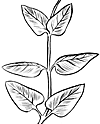Malaysian Apple
Syzygium malaccense
Eucalyptus-Like family (Myrtaceae)
Polynesian introduction
This species with its red, sometimes pink or white, pear-shaped of apple-like color undoubtedly was introduced by the early Hawaiians. It has large pretty, purplish red or rose purple flowers (sometimes whitish) composed of a mass of many threadlike 2 1⁄2–3 inches (6–7.5 ) across, spreading like pins in a pin cushion, which drop to form a purplish red carpet on the ground beneath.

©2007 Forest And Kim Starr
Leaves hairless, with stout green to brown leaf-stalks of 1⁄2–3⁄4 inch (1.3–2 ). Blades large oblong, 7–12 inches (18-30 ) long and 3–5 inches (7.5–13 ) broad, long-pointed at short-pointed at base, leathery, slightly curved upward on both sides of side veins slightly sunken and connected near straight margins. Upper surface dark green or green and slightly shiny, lower surface dull light green, with scattered tiny -dots visible under a lens.
Flower clusters ( or ) 4–5 inches (10–13 ) across several to many almost stalkless flowers at end of short branched green lateral axis along branches back of leaves and trunk. Flowers odorless, with funnel-shaped light purplish green base () 3⁄4 inch (2 ) long and more than 3⁄8 inch (1 ) wide at top, enclosing and extending as broad tube 3⁄16 inch (5 ) beyond. of four broad rounded thickened 1⁄8–3⁄16 inch (3–5 ) long; 4 spreading rounded concave purplish red petals 1⁄2 inch (13 ) long; many spreading 1–1 1⁄4 inches (2.5–3 ) long, purplish red with yellow dot and composed of inferior two-celled and purplish red straight about 1 1⁄4 inches (3 ) long.
(berries) pear-shaped, 2–3 inches (5–7.5 ) long and 1–2 inches (2.5–5 ) in diameter, red (sometimes pink or white), with four at thin soft skin, and white crisp juicy pulp with pleasant slightly sour or sweet flavor suggesting apple. Seed single, large, rounded, 3⁄4 inch (2 ) in diameter, light brown. Flowering mainly in March and April or irregularly and maturing in summer and autumn.
Sapwood light brown, heartwood reddish brown, straight-grained, and fine-textured. Wood is described as hard, tough, very heavy, tending to warp and difficult to work. Hawaiians hewed the trunks into posts, rafters for houses, and enclosures for temples. Religious images were carved from the wood, which was regarded as sacred. A tea brewed from bark was used as a sore remedy.
Widely cultivated through the tropics. are eaten raw, cooked, or preserved. It is said that the slightly sour are good in salads. Elsewhere astringent bark, flowers, and leaves have been used in folk remedies.
An attractive ornamental and shade tree, planted elsewhere for windbreaks. One author places it among the most beautiful flowering trees of the tropics. Easily propagated from seeds, it has moderately rapid growth. are produced in 7–8 years.
The Malaysian apple was introduced into Jamaica in 1793 from Tahiti by Captain William Bligh of the British ship Providence. This, along with breadfruit, was one of several trees brought in to provide inexpensive food for slaves.
Naturalized in moist lowland forests through the Hawaiian Islands, mainly on windward sides in valleys and gorges. It forms almost pure stands to about 1800 ft (549 in) altitude. Accessible groves on Oahu are in Waimano Gulch and Sacred Falls Valley (Kaliuwaa), also along Trail Number 1 in upper Makiki Valley and Kahana Valley. The form with white flowers and rare on Oahu, was named ‘ōhi‘a‘ai hua keokeo or ‘ōhi‘a kea.
Special areas
Waimea Arboretum, Foster.
Champion
Height 35 ft (10.7 ), c.b.h. 4.8 ft (1.5 ), spread 20 ft (6.1 ). Kaelakehe, Kailua-Kona, Hawaii (1968).
In Puerto Rico and Virgin islands, trees are grown around buildings as ornamentals, also occasionally for windbreaks. Uncommon in southern Florida.
Range
Native probably of Malay Peninsula or Malay Archipelago. Widely planted through tropics.








